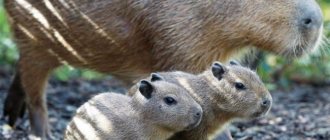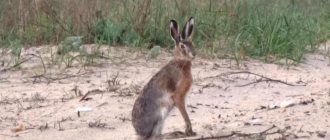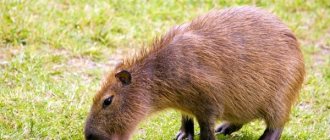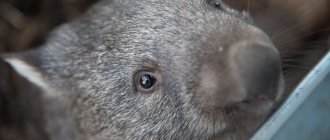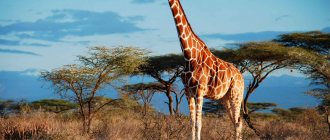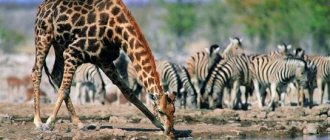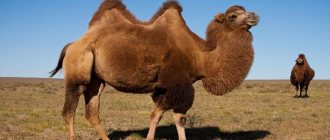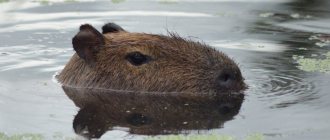21 July59734squad rodentscapybaralargecapybara
The capybara, or as it is also called, the capybara, is a semi-aquatic animal that is a representative of the order of Rodents. This is a very unusual animal and many will be interested in meeting it. The capybara animal is the largest rodent. Below you will find a description and photo of the capybara animal, and also learn a lot of new things.
Description and origin of the species
First scientific description and modern scientific name Hydrochoerus hydrochaeris
The animal was given by the Swedish naturalist Carl Linnaeus in 1766. The capybara belongs to the class Mammals, order Rodents. The animal belongs to the family Caviidae, together with the genus Kerodon - stone caverns. For a long time, the capybara was classified as a separate family of water pigs, Hydrochoeridae. Since 2002, molecular analysis has revealed the close relationship between caves and rock caverns, after which both genera of animals were assigned to the same family and subfamily Cavies Caviidae.
The name capybara was borrowed from the Tupi Indian language. The word ka'apiûara
formed from several words -
kaá
(leaves) +
píi
(thin) +
ú
(eat) +
ara
(suffix for the subject), and literally translates as “that.
who eats thin leaves,” or, more simply, “grass eater.” In Colombia, the animals are sometimes called "cuartins". The scientific name of the animal, both parts hydrochoerus
and
hydrochaeris,
are derived from the Greek words
hydro
(water) and
choiros
(pig, pig), and translated mean capybara.
Nutrition
Capybaras prefer plants rich in protein. With their sharp teeth they seem to be cutting grass. The favorite foods of domestic capybaras are grains, fruits and vegetables, melons and sugar cane. If there is a lack of algae, rodents can eat tree bark.
Sometimes they do not disdain their own droppings; such food is easily digestible. In zoos, their diet is somewhat different. There they are given special granules for rodents and various vitamin complexes.
What does a capybara look like?
The capybara has a massive, barrel-shaped body, a large, almost rectangular head with a blunt muzzle. In appearance, the animal resembles a giant guinea pig, which is clearly visible in the video.
The color is reddish-brown, changing to a yellowish-brown shade on the belly. The animal does not have undercoat, unlike many other animals. The coat is uniform with long and coarse hair up to 120 mm. The guard hair is practically no different from the main one.
Adult capybaras are impressive in size and are the largest rodents on earth among living species. The animals grow in length from 106 to 134 cm, the height at the withers is about 50-62 cm. The weight of the capybara varies from 35 to 66 kg, with an average of 48.9 kg. Females are slightly heavier than males. Record weights in the entire history of observations are 91 kg for a female and 73.5 kg for a male.
The hind legs of the animal are slightly longer than the front ones. The animal has a small, vestigial tail; it is almost invisible. The feet are partially webbed, there are 4 toes on the front feet and 3 on the hind feet. The eyes are small, and there are small round ears. The nostrils, eyes and ears are set high, which is an adaptation to a semi-aquatic lifestyle.
Where does the capybara live?
The capybara lives in all countries of South America except Chile. It lives in tropical and temperate parts of South America east of the Andes Mountains, from Panama to northeastern Argentina. The animals that escaped from captivity are gradually settling in other continents. A stable population has formed on the island of Trinidad. In the 2010s, wild animals were also spotted in California and Florida.
The animals inhabit dense forests near bodies of water - rivers, lakes, ponds, swamps, and also live along rivers in tropical forests and flooded savannas. The animal's habitat is limited by air and water temperatures. It is found at altitudes of up to 1,300 meters above sea level, and prefers warm water, in particular the Amazon, Orinoco, and La Plata river basins. .
Family
They prefer to live in groups of about 10 individuals each. If there is enough food, the group can consist of 30 animals. They are very rarely in pairs.
During drought, separate groups gather together near a reservoir. After the end of the dry season, they return to their usual composition.
A typical capybara family is led by a dominant male, several females, pairs of subordinate males, and growing individuals.
Females are loyal in their relationships with each other. A dominant male periodically demonstrates his superiority over others.
Families live on an area of about 10 hectares. The boundaries of possessions are marked with special glands.
What does a capybara eat?
The capybara is a herbivore and feeds on plant matter. Animals eat grass, aquatic vegetation and tree bark. The animals are quite picky - if they have chosen one type of plant, they eat only certain leaves, completely ignoring other types of vegetation.
During the dry season, animals have to expand their diet, since there is little vegetation during this period. During the rainy season, rodents eat grass more often; during periods of drought, they switch to reeds, since there is noticeably less grass. The grass they eat in the summer loses its nutritional value in the winter, so the animals don't eat grass in the winter. The animal's jaws are designed in such a way that the capybara chews grass, moving its jaws back and forth, and not sideways, like other ruminants. .
Coprophagia is observed in animals - capybaras eat their own poop in order to improve the bacterial flora in the digestive tract, better absorb cellulose from grass and extract maximum nutrients from food. Like domestic ruminants, capybaras often regurgitate food and then chew it again. Like other rodents, the animal's front teeth continually grow to compensate for constant wear and tear. Chewing teeth are also constantly growing.
Like guinea pigs, capybaras cannot synthesize vitamin C and must obtain it from their diet. At home, animals must be given vitamin C supplements, otherwise they will develop gum disease, which is a precursor to scurvy.
Price
These large rodents are purchased by cottage owners who want to have an exotic animal, or by owners of private zoos. It is not uncommon on the Internet to advertise that a capybara ; the price for it can reach 100 thousand or more rubles.
In addition to the costs of veterinary care, you will have to calculate the costs of building an enclosure and a swimming pool. During construction, it is necessary to take into account that the domestic capybara is a heat-loving animal. The least financial problems will arise when organizing the capybara's diet - its diet is simple and affordable.
Character and lifestyle
Capybaras lead a semi-aquatic lifestyle. Animals feel at home in the water, while being quite fast and agile on land. If they are not bothered by predators, the animals are active during the day; in case of danger, capybaras are active at night. They rest until midnight, then graze until dawn.
Capybaras are excellent swimmers and can stay underwater for up to 5 minutes. This ability helps them escape from terrestrial predators. Animals can even sleep in water, keeping only their nose above the surface of the water. In hot weather, capybaras spend whole days in the water, climbing out onto land only in the evening. They also spend a lot of time wallowing in the mud.
Capybaras live in groups of 10-20 individuals. The group usually consists of 2-4 adult males, 4-7 adult females, and young. During periods of drought, the group size increases to 50-100 animals, as the animals gather at the remaining water sources. Groups are led by males. Capybaras make short barking sounds when in danger or when mothers gather their young.
Animals have 2 types of scent glands - anal glands and morillo glands, located on the face. Males have larger glands, and they use them more often, leaving scent marks on plants, trees and stones. Males also mark females with their scent. To make a mark, animals rub their anal glands or snout against the object. Urine enhances the smell, but females practically do not use this method. Females are much more likely to leave scent marks during the rainy season when they come into estrus.
Keeping at home
In some states of Brazil, capybara meat is considered completely edible, in addition, the Catholic Church does not object to the consumption of capybara flesh during Lent and even during Holy Week. This led to capybaras being kept as farm animals.
Raising them on farms is not much different from keeping other herbivores. Capybaras do not require special facilities or special conditions. It is enough to build a pen of sufficient area in a swampy area. The larger the paddock, the less imported green mass will be required.
Capybaras, in many cases, approach human habitation on their own initiative. In fact, they became synanthropic animals. Entire families settle in parks and suburban areas. Where capybara and man live side by side. Capybaras do not avoid the attention of people; on the contrary, they try to beg for food.
Their unusual appearance and docile nature brought capybaras into people’s homes. In terms of gentleness in communication and desire to contact people, capybaras are ahead of many domestic animals. Size, weight, and good appetite limit the ability to keep rodents in a city apartment.
Owners of cottages with a large plot of land near their house choose to own a capybara. Animals not only need living space, they need water - a natural or artificial shallow pond. Capybaras can live alone, but they begin to get bored, so it is advisable to have not one, but several animals at once.
For a capybara to live comfortably, it is necessary to build an enclosure. When living in the middle zone, where cold, long winters occur, a heated room should be built into the enclosure. The winter house for capybaras will have to be equipped with a heated pool.
There are few problems with animal nutrition. Vegetables and fruits are combined with grain and hay to create a mixture that capybaras happily eat. You have to experiment with the volume of food. Everything that is offered to the animal must be absorbed during the day. The uneaten portion is removed and the diet is reduced.
Reproduction and young
The peak mating season is April-May in Venezuela, and October-November in Brazil. During the period of estrus, the female's scent changes, and males nearby begin to pursue. In addition to the smell, the female notifies the males about estrus by emitting a slight whistle with her nose. The choice of mating partner remains with the female. Capybaras only mate in water, so if a female does not want to mate with a particular male, she will dive or leave the water altogether.
Dominant males protect females from their group, but cannot prevent them from mating with subordinate males lower in the group hierarchy. The larger the group, the less attention the dominant males can pay to each female. Dominant males have a higher chance of mating with a female, but subordinate males as a class have more matings than dominant males.
Pregnancy lasts 130-150 days. One to eight puppies are born in one litter, with an average of 4 cubs. Females give birth on land, and join the group with their newborns just hours after giving birth. Baby capybaras are born well prepared for an active life - with teeth, fur and open eyes. At birth, the cubs weigh about 1.5 kg.
After a week, the puppies are already eating grass, but continue to suckle up to 16 weeks. Adult capybaras care for all the young in the group, not just their own pups. Thus, the cubs receive breast milk not only from the mother, but also from other females of the group. Young capybaras reach sexual maturity at 15-18 months, with a live weight of about 30-40 kg. A female can give birth to 2-3 litters per year under favorable conditions, but more often females give birth only once a year.
Interesting Facts
In the 16th century (according to other sources in the 17th century), the clergy of Venezuela sent a letter to the Vatican. In it they described the animal spending most of its time in water. They asked to clarify whether the meat of this semi-aquatic inhabitant can be eaten on fasting days.
In a response letter, the church leadership, to the delight of the Venezuelan people, allowed them to eat capybara meat all year round, including during fasting times, when eating fish is allowed. In addition to the capybara, the list of mammals that can be considered fish includes beavers, aquatic turtles, iguanas and muskrats.
Capybaras distinguished themselves not only in cult, but also in medical practice. They will probably make their contribution to the fight against tumor diseases in the near future. It all started with a paradox, which is based on a simple conclusion.
The larger the animal, the more cells there are in its body. Each can begin to divide uncontrollably, that is, become cancerous. This means that the likelihood of a tumor occurring in a large organism containing many cells is higher than in a small body.
In practice, such a dependence is not observed. Elephants suffer from cancer no more often than mice, and whales get sick less often than humans. This means there is control over cells with defective DNA. This phenomenon is called Peto's paradox, after the English physician who formulated the contradiction.
A special genetic mechanism has so far been discovered only in capybaras. The capybara rodent has an immune system that detects and destroys cells that are trying to become cancerous and have begun to divide uncontrollably. Capybaras, especially in old age, suffer from cancer. But in many cases, the focus of the disease is eliminated at the moment of its inception.
Natural enemies
The capybara is hunted by many predators, including jaguars, pumas, ocelots, eagles, caimans and anacondas. For the green anaconda, the animal is a favorite treat. Birds of prey carry away small capybaras. The animal hides from land-based predators in the water and breathes through its nostrils, which remain on the surface.
Below is a funny video of a pelican trying to eat a capybara.
Vocalizations
Capybara vocalizations are unique among rodents. When a predator is close or approaching, they emit a loud sound that will continue until the predator leaves or the entire group enters the water for protection. Young or newborn capybaras whistle when they need their mother, and they will not stop making this sound until the mother returns. Adult females also vocalize when searching for an adult male. Likewise, the female will not stop until the male comes. Feelings of contentment are expressed by a low clicking sound, while grunts or purrs reveal their submissive mood. Males chatter their teeth angrily to show their aggressive mood.
Population and protection of the species
Capybaras are included in the International Red Book with the status of a species of least concern. The capybara population in South America is currently stable, although in some regions the number of animals may be declining due to active fishing.
- The animals are hunted for their skin and cape.
- Capybaras are killed by farmers due to competition for food supply with livestock.
Capybaras survive due to their ability to reproduce quickly. In addition, the animals adapt well to urbanization and the expansion of agricultural land: they can often be found in parks, fields and pastures. Capybaras are also farmed for their meat and skins. The animal's meat is popular in some regions of South America, particularly in Venezuela.
Capybaras are known for their good nature; the animals willingly allow humans to pet and feed them. By nature, these animals are one of the most good-natured in the world, which is why they are often kept as pets.
Water pigs are calm, friendly animals, they are willing to make contact and get along well with other pets, including dogs.
